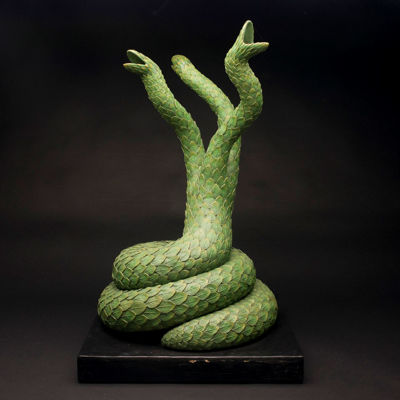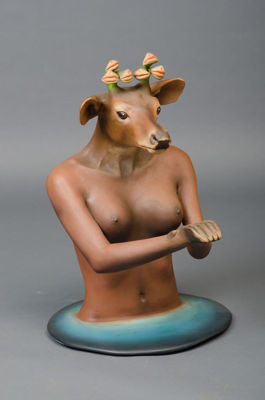Jack Thompson
Title: Asparagus Buddess
“Asparagus Buddess” is pulled from the semi-conscious compound of imagery and narrative that Jack Thompson has developed as a sculptor, presenting the idea for a method of communication through shared physical, phsychological and mythical imagery. Having collected a vast range of clay molds over 35 years of practice, he combines elements of older work with newer ones to create disparate or jarring composites. Here a meditative female form clashes with the phallic asparagus, the combination of differences giving the latter a seemingly violent symbolism. The airbrushed gunmetal patina loosely imparts an impression of cast iron, though its ultimate failure to conceal material origin heightens the sense of pastiche and a clashing of aspects that Thompson mischievously seeks.
Title: Barco De Los Antepasados
The manifestation of various spiritual, mythical and religious influence often becomes more defined the further back into Thompson’s oeuvre you move, as 1994 piece “Barco de los Antepasados” (or “Ancestor Boat”) presents with its four prostrating figures seated on a long boat. The ceramic’s five separate constitutional parts, scale, and overall design give the work a playfully toylike feel — which revels in proximity to a conscious religious or sacred iconography. A muted metallic finish applied by the artist with an airbrush over several layers heightens the sense of curious tactility. Thompson prefers to dilute specific cultural reference with his sculpture, using his practice to hint at common internal symbolic and psychological bonds
Title: Wapiti
The semi-mythic creations of Thompson find a language in shared, decentralised symbolism — exploring identity as thrown onto objects by artist or viewer, or insinuated in coincidental action or operation. ‘Wapiti’ is a sculpture of particularly vivid and monstrous proportion, the artist utilising a combination of hand-build elements and new and existing moulds to build his ceramics — the practice extending the unconscious state in which results are arrived at. In opposition to later, more muted or metallic palettes, the work is finished with a vibrancy and naturalism applied in a full spectrum of airbrushed acrylic paint, and the overall scale and detail of the hybrid female/deer aspect is readily conducive of religious or pagan deities.






